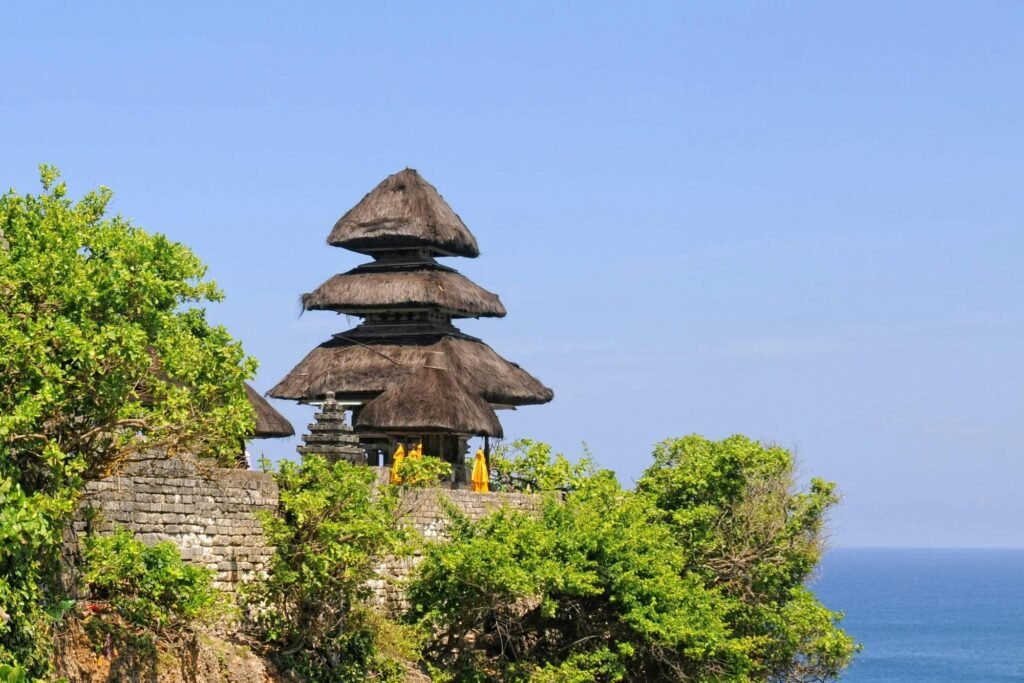DOWNLOAD YOUR FREE 24-HOUR BALI ITINERARY
Discover Bali’s Iconic Landmarks
Bali, known as the Island of the Gods, is home to stunning landscapes, vibrant culture, and breathtaking historical sites. Among the top places to visit in Bali is the revered Uluwatu Temple, perched on a cliff overlooking the Indian Ocean. This ancient temple offers stunning views and a glimpse into Bali’s rich spiritual heritage.
Explore Nature’s Splendor
Bali’s enchantment extends beyond its cultural sites. Nature lovers will find solace in the lush green terraced rice fields of Tegalalang, located just north of Ubud. These picturesque vistas not only offer spectacular photo opportunities but also allow visitors to learn about traditional Balinese farming methods.
Experience the Vibrant Local Culture
No visit to Bali is complete without immersing oneself in its vibrant local culture. The town of Ubud is a cultural hub, where travelers can explore art galleries, traditional markets, and the famous Ubud Monkey Forest. This sanctuary is home to hundreds of long-tailed macaques and provides a unique opportunity to connect with nature and wildlife.
Bali offers a plethora of attractions that cater to all types of travelers. Whether you are seeking adventure, relaxation, or a cultural experience, the top places in Bali are sure to create unforgettable memories. Plan your visit to witness the beauty and diversity that this magical island has to offer.

Uluwata Temple
The Origins of Uluwatu Temple
The Uluwatu Temple, known as Pura Luhur Uluwatu, is one of the six key temples believed to be the spiritual pillars of Bali, Indonesia. This magnificent sea temple is strategically perched on a steep cliff, approximately 70 meters above the ocean, offering stunning views of the Indian Ocean. Established in the 10th century, it was initially constructed as a place of worship for the sea gods, particularly for those invoking protection against evil spirits.
Architectural Significance
The architecture of Uluwatu Temple is a profound representation of Balinese culture and spirituality. The temple complex comprises several shrines that follow traditional Balinese designs, characterized by intricate carvings and exquisite stonework. The most notable feature is the Kecak dance performance held nightly at the temple, showcasing the rich heritage and artistic expression of the region. This cultural conjunction elevates Uluwatu Temple as not only a religious site but also a center of identity for the Balinese people.
Preservation and Tourism
Over the years, Uluwatu Temple has transcended its original purpose, evolving into a significant tourist destination. Efforts to preserve the temple’s integrity are paramount, ensuring that it remains a vital part of Bali’s cultural heritage. Visitors flock to experience not just the breathtaking views and the sunset, but also to engage in the spirituality and vibrant rituals that Uluwatu Temple embodies. The temple continues to be a symbol of resilience and spirituality, drawing both locals and tourists alike to appreciate its historic and cultural importance.
DOWNLOAD YOUR FREE 3-DAY ROME ITINERARY
Introduction to the Colosseum
The Colosseum, known as the Flavian Amphitheatre, stands as one of the most iconic structures in ancient Rome. Erected between A.D. 70 and A.D. 80 under the emperors Vespasian and Titus, this monumental arena was designed to host public spectacles, including gladiatorial contests and dramatic performances.
Architectural Marvel
The Colosseum boasts remarkable architectural features, such as its elliptic shape and the use of concrete, which were revolutionary for its time. With a seating capacity of around 50,000 spectators, it became a hub of entertainment in ancient Rome. The structure measured approximately 189 meters long, 156 meters wide, and 48 meters high, showcasing the engineering prowess of the Romans.
Significance and Legacy
Throughout its history, the Colosseum has been a symbol of the might and decadence of the Roman Empire. It was not just a sports venue, but also a site for public execution and mock sea battles, highlighting the brutal nature of entertainment during that era. Over the centuries, the Colosseum suffered from damage due to earthquakes and stone quarrying, yet it remains a testament to ancient Roman engineering. Today, it attracts millions of visitors annually, further solidifying its place as a cultural icon and a reminder of Rome’s glorious past.

